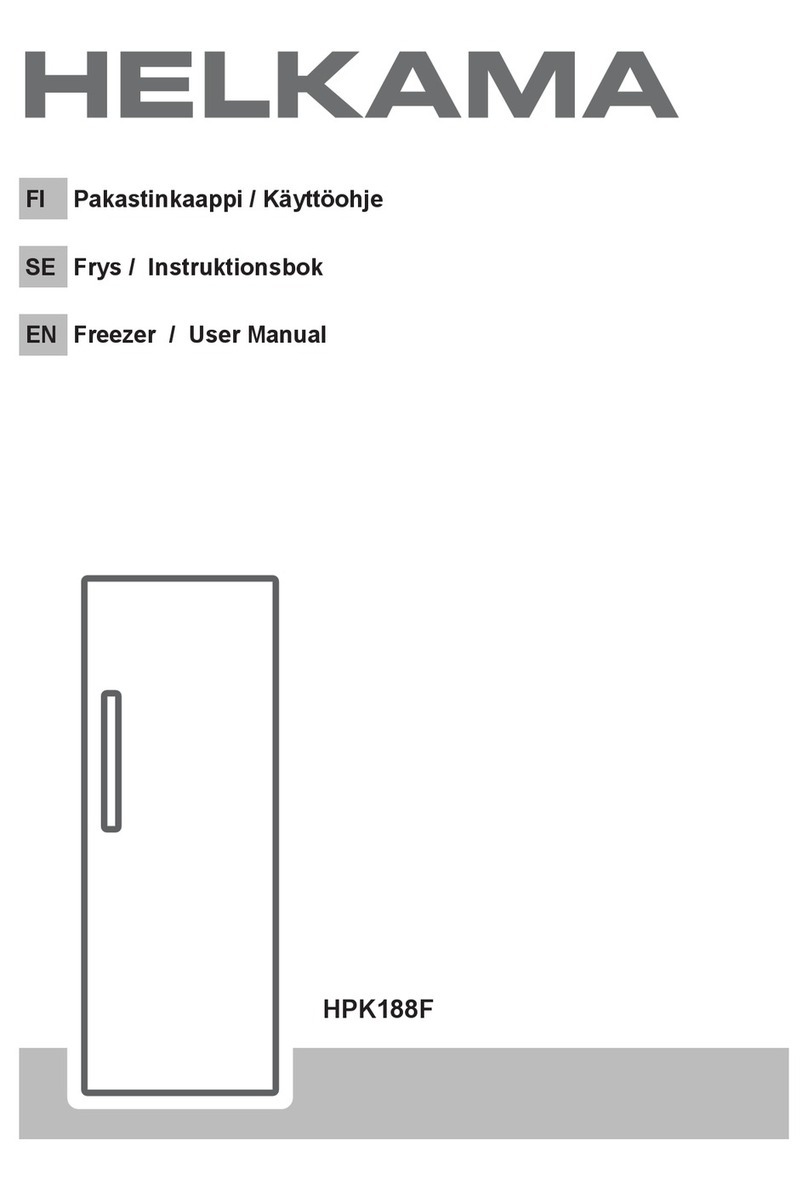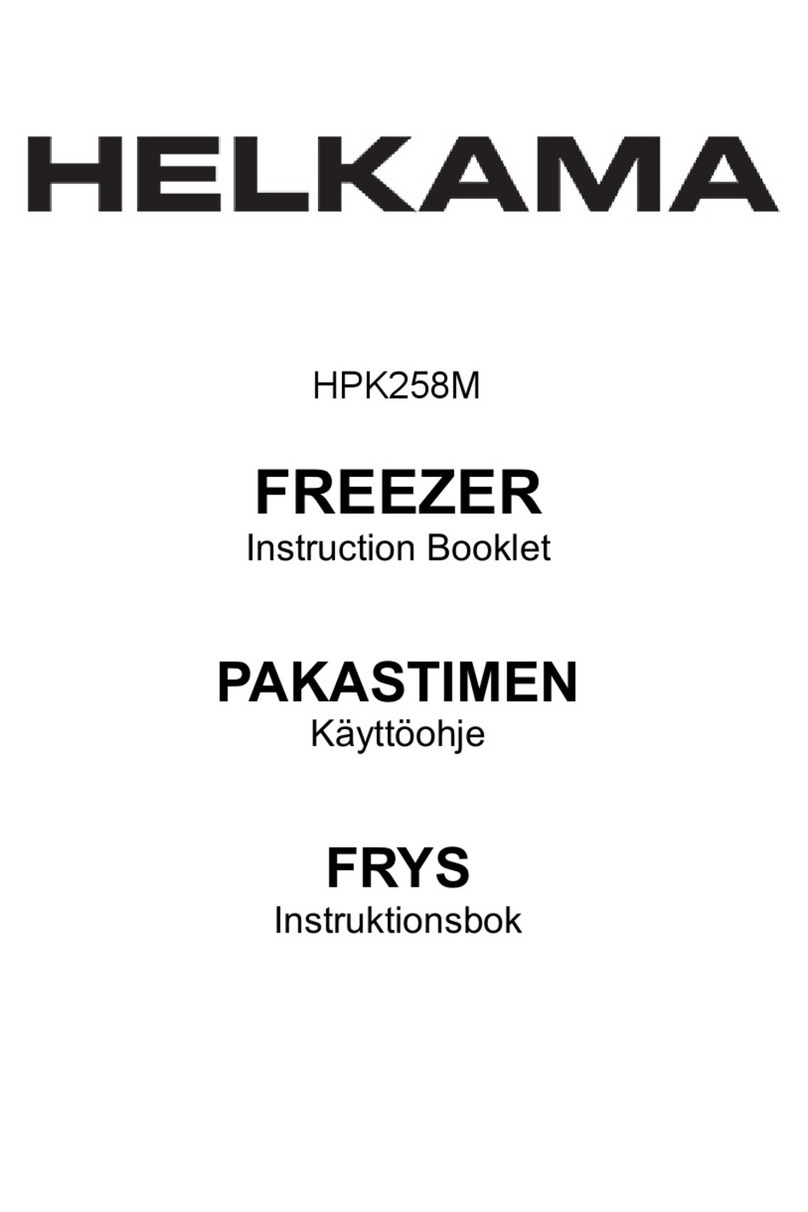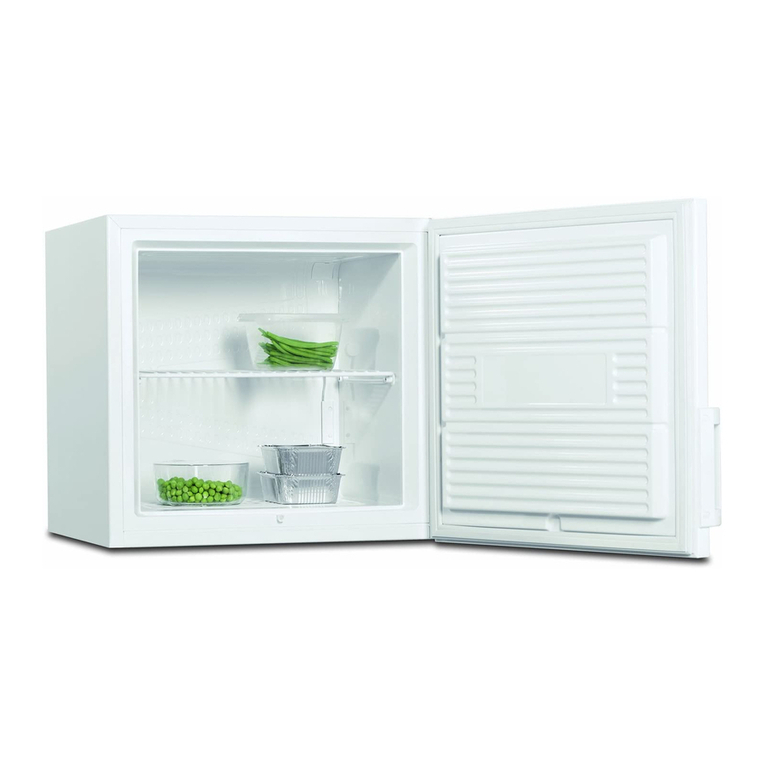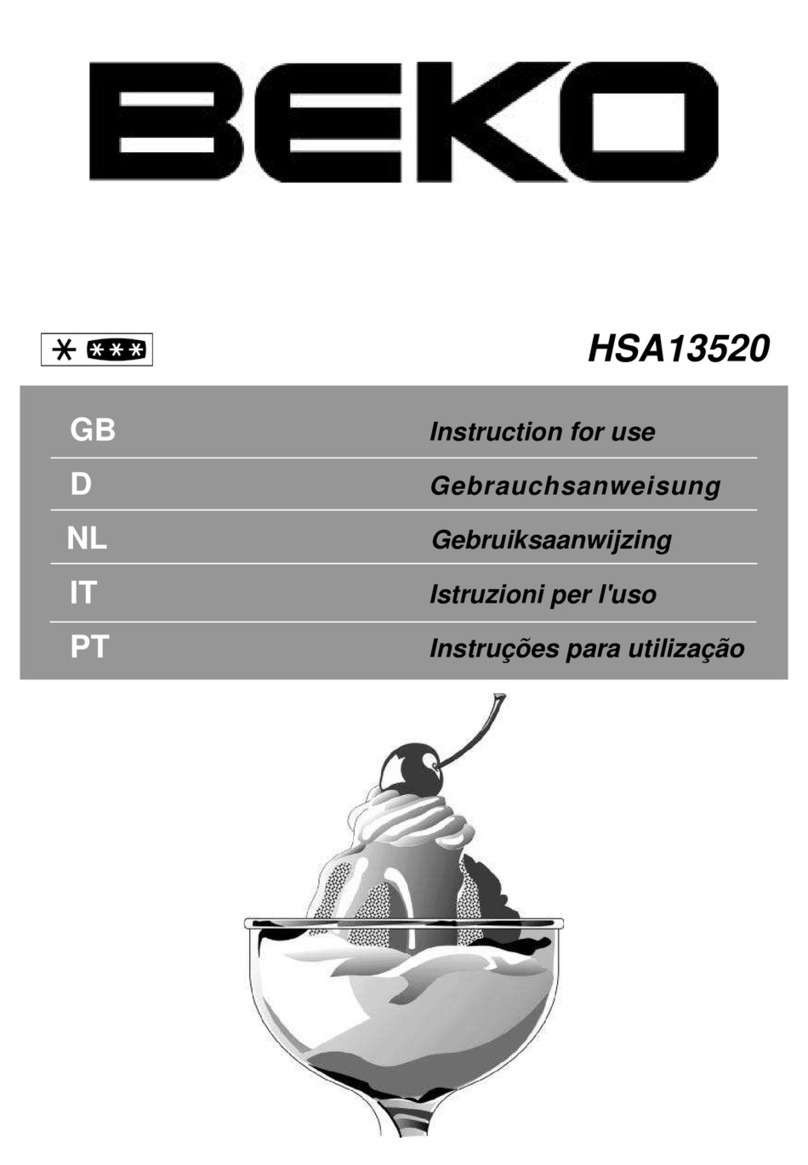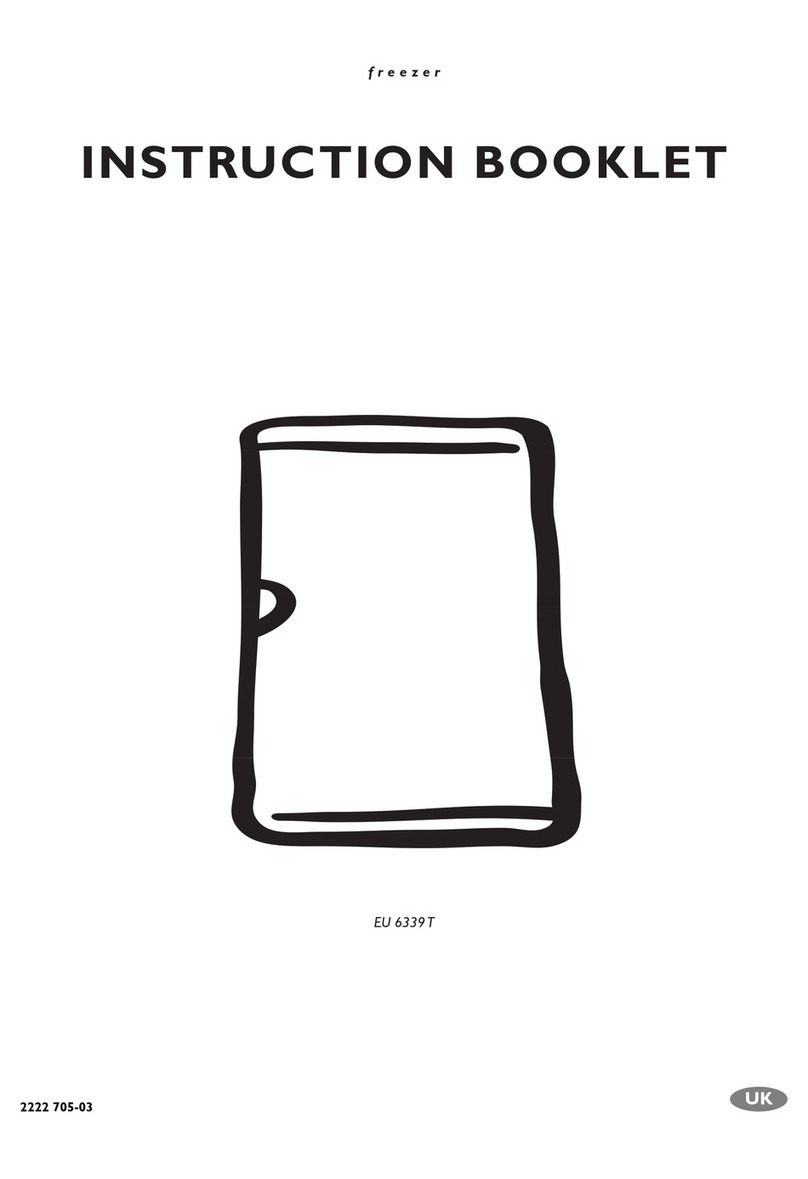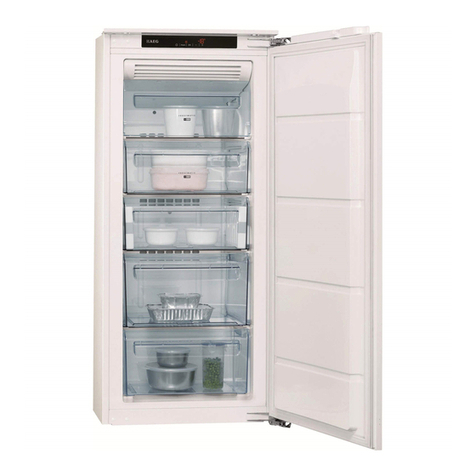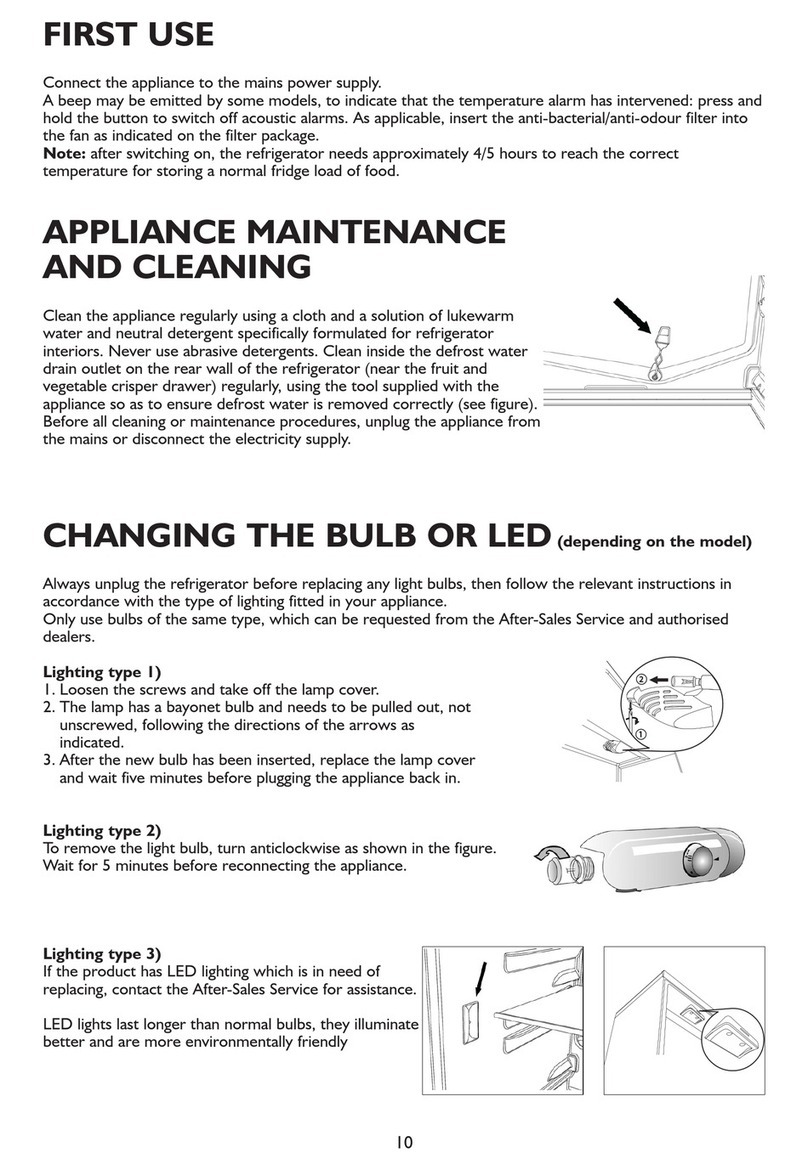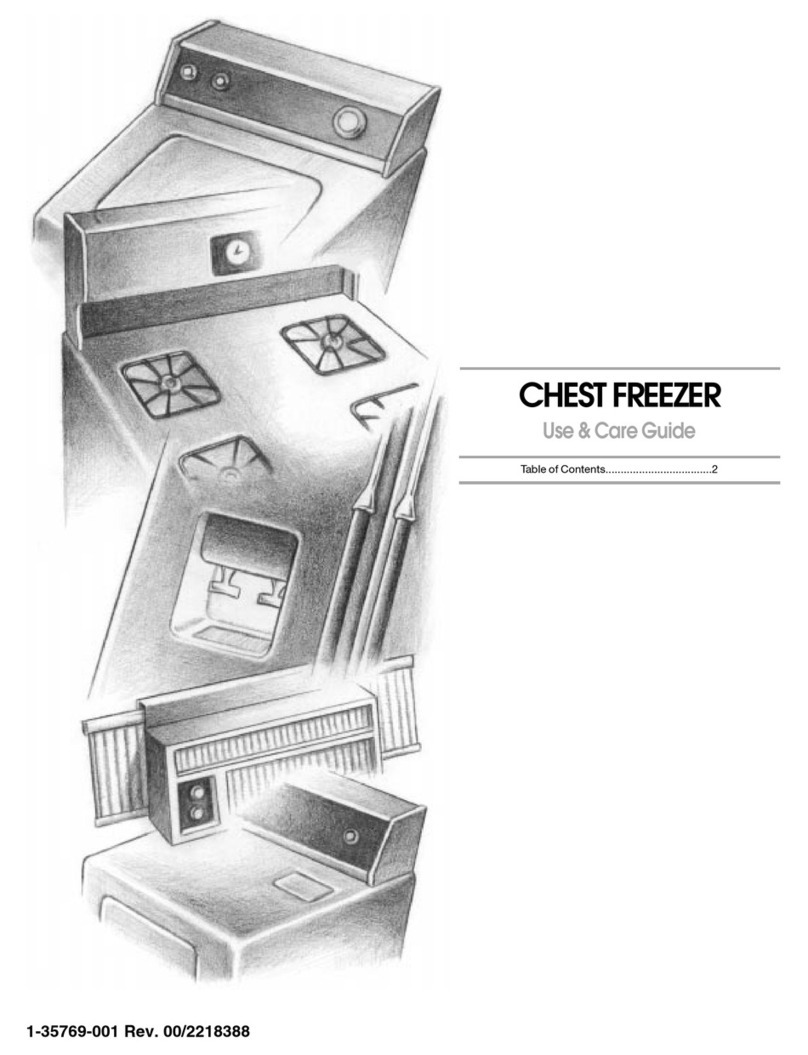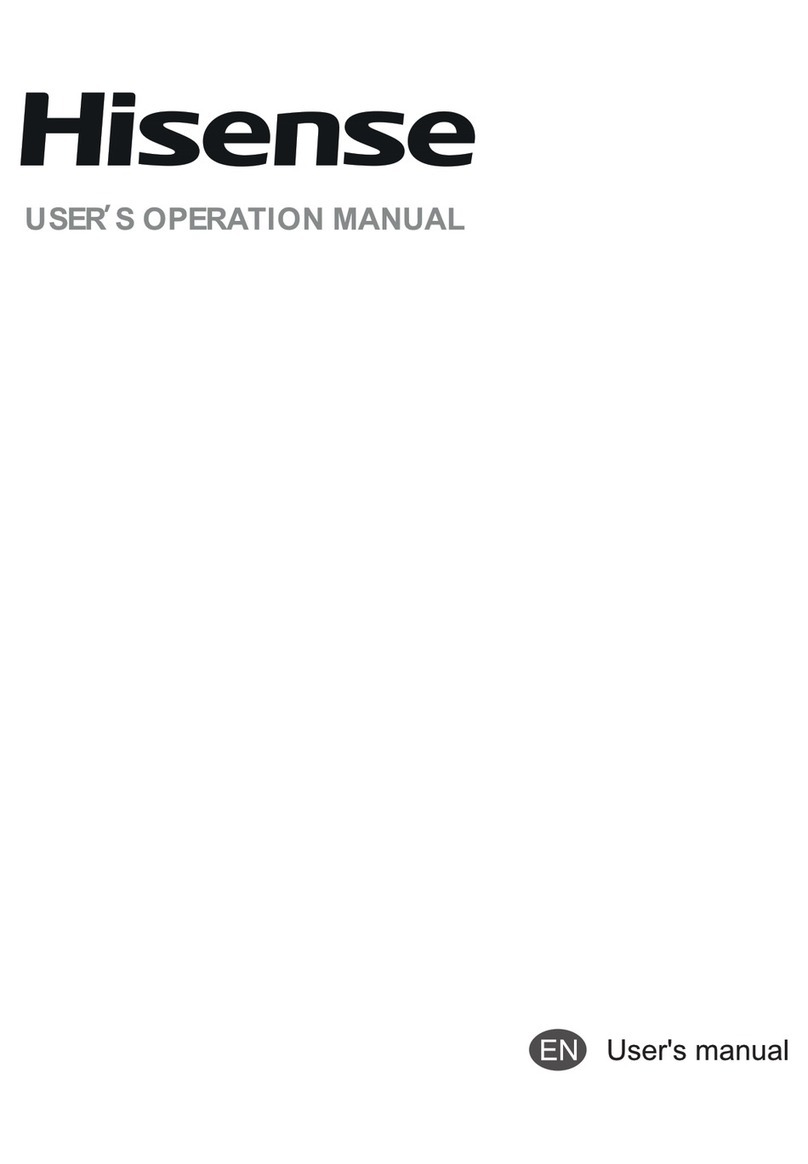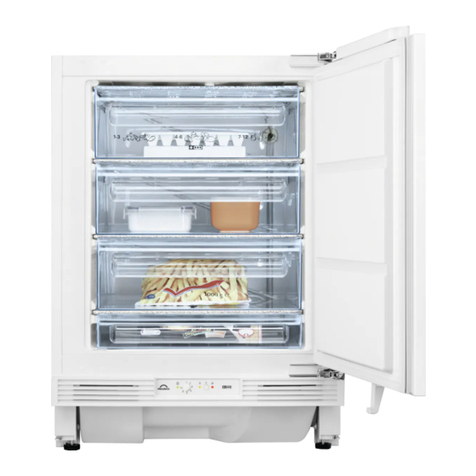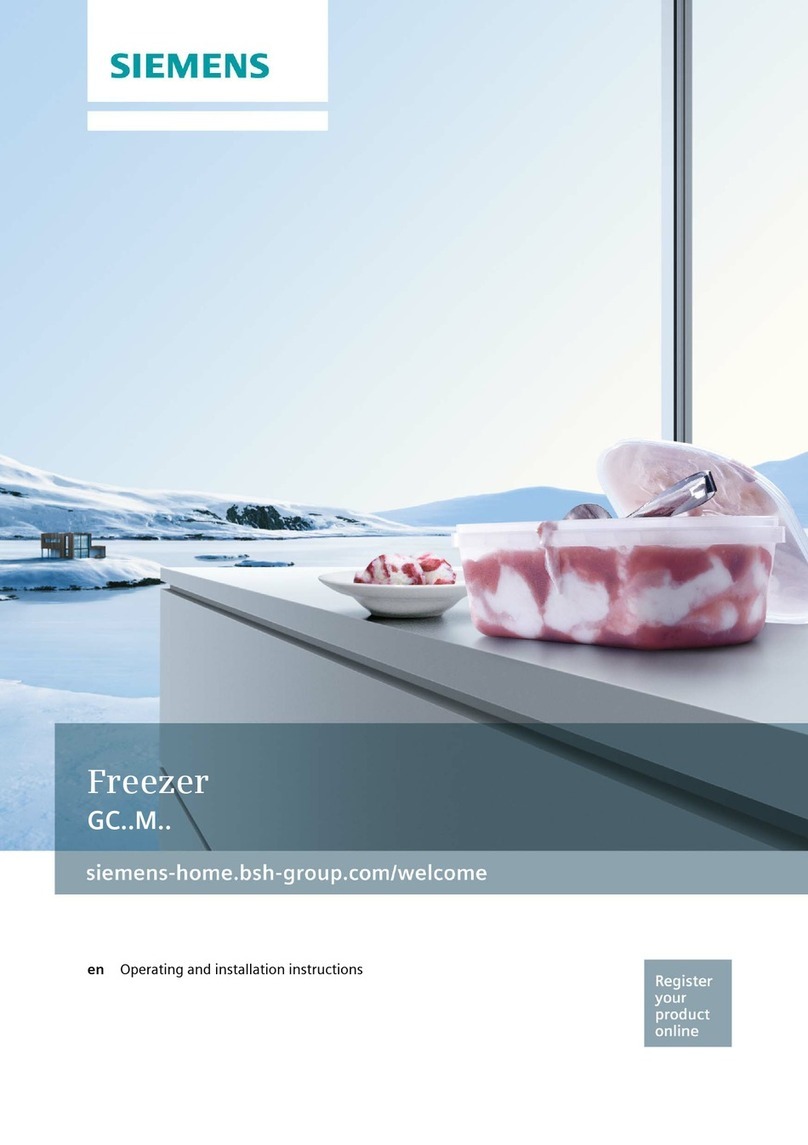HELKAMA HPK258SB SS User manual

HPK258SB SS
FREEZER
User manual
FRYS
Instruktionsbok
PAKASTIMEN
Käyttöohje


EN - 1 -
Contents
BEFORE USING YOUR APPLIANCE ...................................................... 2
General warnings ............................................................................................. 2
Old and out-of-order fridges ............................................................................. 5
Safety warnings................................................................................................ 5
Installing and operating your freezer ................................................................ 6
Before using your freezer ................................................................................. 6
Information on No-Frost technology ................................................................. 7
USAGE INFORMATION............................................................................ 7
Operating your freezer ..................................................................................... 7
MODE Button ........................................................................................................... 7
SET Button............................................................................................................... 8
Freezer compartment temperature adjustment and activating Fast Freezing Mode 8
Fast freezing mode .................................................................................................. 8
Economy mode ........................................................................................................ 9
Warnings about temperature adjustments........................................................ 9
PLACING THE FOOD.............................................................................. 10
CLEANING AND MAINTENANCE .......................................................... 14
Defrosting ........................................................................................................ 14
TRANSPORTATION AND CHANGING OF INSTALLATION POSITION 15
Repositioning the door .................................................................................... 15
BEFORE CALLING SERVICE................................................................. 15
Advice for Saving Energy ................................................................................ 17
THE PARTS OF THE APPLIANCE AND THE COMPARTMENTS ......... 18
Warning: Risk of re / ammable materials

EN - 2 -
BEFORE USING YOUR APPLIANCECHAPTER 1.
General warnings
WARNING: Keep ventilation openings, in the appliance
enclosure or in the built-in structure, clear of obstruction.
WARNING: Do not use mechanical devices or other means
to accelerate the defrosting process, other than those
recommended by the manufacturer.
WARNING: Do not use electrical appliances inside the food
storage compartments of the appliance, unless they are of the
type recommended by the manufacturer.
WARNING: Do not damage the refrigerant circuit.
WARNING: To avoid a hazard due to the instability of the
appliance, it must be xed in accordance with the instructions.
WARNING: When positioning the appliance, ensure the supply
cord is not trapped or damaged.
WARNING: Do not locate multiple portable socket-outlets or
portable power supplies at the rear of the appliance.
• If your appliance uses R600a as a refrigerant (this information
will be provided on the label of the cooler) you should
take care during transportation and installation to prevent
the cooler elements from being damaged. R600a is an
environmentally friendly and natural gas, but it is explosive.
In the event of a leak due to damage of the cooler elements,
move your fridge away from open ames or heat sources
and ventilate the room where the appliance is located for a
few minutes.
• While carrying and positioning the fridge, do not damage the
cooler gas circuit.
• Do not store explosive substances such as aerosol cans
with a ammable propellant in this appliance.
• This appliance is intended to be used in household and
domestic applications such as:
- staff kitchen areas in shops, ofces and other working

EN - 3 -
environments.
- farm houses and by clients in hotels, motels and other
residential type environments.
- bed and breakfast type environments;
- catering and similar non-retail applications.
• If the socket does not match the refrigerator plug, it must be
replaced by the manufacturer, a service agent or similarly
qualied persons in order to avoid a hazard.
• A specially grounded plug has been connected to the power
cable of your refrigerator. This plug should be used with a
specially grounded socket of 10 or 16 amperes depending
on socket loading. If there is no such socket in your house,
please have one installed by an authorised electrician.
• This appliance can be used by children aged from 8 years
and above and persons with reduced physical, sensory or
mental capabilities or lack of experience and knowledge if
they have been given supervision or instruction concerning
use of the appliance in a safe way and understand the
hazards involved. Children shall not play with the appliance.
Cleaning and user maintenance shall not be made by
children without supervision.
• Children aged from 3 to 8 years are allowed to load and
unload refrigerating appliances. Children are not expected
to perform cleaning or user maintenance of the appliance,
very young children (0-3 years old) are not expected to use
appliances, young children (3-8 years old) are not expected
to use appliances safely unless continuous supervision is
given, older children (8-14 years old) and vulnerable people
can use appliances safely after they have been given
appropriate supervision or instruction concerning use of the
appliance. Very vulnerable people are not expected to use
appliances safely unless continuous supervision is given.
• If the supply cord is damaged, it must be replaced by the
manufacturer, an authorised service agent or similar qualied

EN - 4 -
persons, in order to avoid a hazard.
• This appliance is not intended for use at altitudes exceeding
2000 m.
To avoid contamination of food, please respect the
following instructions:
• Opening the door for long periods can cause a signicant
increase of the temperature in the compartments of the
appliance.
• Clean regularly surfaces that can come in contact with food
and accessible drainage systems.
• Store raw meat and sh in suitable containers in the
refrigerator, so that it is not in contact with or drip onto other
food.
• Two-star frozen-food compartments are suitable for storing
pre-frozen food, storing or making ice cream and making ice
cubes.
• One-, two- and three-star compartments are not suitable for
the freezing of fresh food.
• If the refrigerating appliance is left empty for long periods,
switch off, defrost, clean, dry, and leave the door open to
prevent mould developing within the appliance.

EN - 5 -
Old and out-of-order fridges
• If your old fridge has a lock, break or remove the lock before discarding it. Children may
get trapped inside it and may cause an accident.
• Old fridges and freezers contain isolation material and refrigerant with CFC. Therefore,
take care not to harm the environment when you discard your old fridge.
Disposal of your old appliance
The symbol on the product or on its packaging indicates that this product may not
be treated as household waste. Instead it shall be handed over to the applicable
collection point for the recycling of electrical and electronic equipment. By
ensuring this product is disposed of correctly, you will help prevent potential
negative consequences for the environment and human health, which could
otherwise be caused by inappropriate waste handling of this product. For more
detailed information about recycling of this product, please contact your local city ofce, your
household waste disposal service or the shop where you purchased the product.
Notes:
• Please read the instruction manual carefully before installing and using your appliance.
We are not responsible for any damage caused due to misuse.
• Follow all instructions on your appliance and instruction manual and keep this manual
in a safe place to resolve any problems that may occur in the future.
• This appliance is produced to be used at houses and it can only be used in a house
for the specied purposes. It is not suitable for commercial or common use. Such use
will cause the guarantee of the appliance to be cancelled and our company will not be
responsible for any losses which are incurred.
• This appliance is produced to be used in houses and it is only suitable for cooling
/ storing foods. It is not suitable for commercial or common use and/or for storing
substances other than food. Our company is not responsible for any losses which are
incurred in the contrary case.
Safety warnings
• Do not connect your freezer to the mains electricity supply using an extension lead.
• Do not plug in damaged, torn or old plugs.
• Do not pull, bend or damage the cord.
• This appliance is designed for use by adults, do not allow children to play
with the appliance or let them hang off the door.
• Never touch the power cord/plug with wet hands as this could cause a short
circuit or electric shock.
• Do not place glass bottles or beverage cans in the ice-making compartment
as they can burst as the contents freeze.
• Do not place explosive or ammable material in your freezer. Place drinks
with high alcohol content vertically in the freezer and make sure that their
tops are tightly closed.
• When removing ice from the ice-making compartment, do not touch it. Ice may cause

EN - 6 -
frost burns and/or cuts.
• Do not touch frozen goods with wet hands. Do not eat ice-cream or ice cubes
immediately after you have taken them out of the ice-making compartment.
• Do not re-freeze frozen goods after they have melted. This may cause health issues
such as food poisoning.
• Do not cover the body or top of freezer with lace. This affects the performance of your
freezer.
• Secure any accessories in the freezer during transportation to prevent damage to the
accessories.
• When the door of the freezer is closed, a vacuum seal will form. Wait for about 1
minute before reopening it.
• This application is optional for easy opening of the
door. With this application, a little condensation may
occur around this area and you may remove it.
Installing and operating your freezer
Before starting to use your freezer, you should pay attention to the following points:
• The operating voltage for your freezer is 220-240 V at 50Hz.
• We do not accept responsibility for any damages that occur due to ungrounded usage.
• Place your freezer where it will not be exposed to direct sunlight.
• Your appliance should be at least 50 cm away from stoves, gas ovens and heater cores,
and at least 5 cm away from electrical ovens.
• Your freezer should never be used outdoors or exposed to rain.
• When your freezer is placed next to a deep freezer, there should be at least 2 cm
between them to prevent humidity forming on the outer surface.
• Do not place heavy items on the appliance.
• Do not place anything on your freezer, and install your freezer in a suitable
place so that at least 15 cm of free space is available above it.
• Use the adjustable front legs to make sure your appliance is level and
stable. You can adjust the legs by turning them in either direction. This
should be done before placing food in the freezer.
• Before using your freezer, wipe all parts with a solution of warm water and a teaspoon
of sodium bicarbonate, then rinse with clean water and dry. Place all parts in the freezer
after cleaning.
• Install the plastic distance guide (the part with black vanes at the rear)
by turning it 90° (as shown in the gure) to prevent the condenser from
touching the wall.
• The freezer should be placed against a wall with a free space not
exceeding 75 mm.
Before using your freezer
• When using your freezer for the rst time, or after transportation, keep it in
an upright position for at least 3 hours before plugging into the mains. This
allows efcient operation and prevents damage to the compressor.
• Your freezer may have a smell when it is operated for the rst time. This is normal and
the smell will fade away when your freezer starts to cool.

EN - 7 -
Information on No-Frost technology
No-frost freezers differ from other static freezers in their operating principle.
In normal freezers, the humidity entering the freezer due to opening the
door and the humidity inherent in the food causes freezing in the freezer
compartment. To defrost the frost and ice in the freezer compartment, you
are periodically required to turn off the freezer, place the food that needs
to be kept frozen in a separately cooled container and remove the ice
gathered in the freezer compartment.
The situation is completely different in no-frost freezers. Dry and cold air is
blown into the fridge and freezer compartments homogeneously and evenly
from several points via a blower fan. Cold air dispersed homogeneously and
evenly between the shelves cools all of your food equally and uniformly,
thus preventing humidity and freezing.
Therefore your no-frost freezer allows you ease of use, in addition to its
huge capacity and stylish appearance.
USAGE INFORMATIONCHAPTER 2.
Operating your freezer
Freezer temperature
indicator
Mode button
Set button Economy mode
lamp
Fast freezing mode
lamp
Power lamp
In some models
MODE Button
• Mode button is used to switch between Freezer
Compartment Indicator, Fast Freezing Mode Lamp and
Economy Mode Lamp.
• When you press the Mode button once, the Freezer
Compartment Indicator starts to ash.
The set value is ready to be changed.
• When you press the Mode button twice, the Fast Freezing Mode Lamp starts to ash.
• When you press the Mode button three times, the Economy Mode Lamp starts to ash.

EN - 8 -
SET Button
Used to adjust the temperature of the related compartment when
the Freezer Compartment Indicator is selected with the Mode
button.
Freezer compartment temperature adjustment and activating Fast Freezing Mode
• The initial temperature value for the freezer indicator is
-18oC.
• Press the Mode button once.
• The set value for the freezer compartment indicator starts
to ash.
• The value for the freezer indicator changes to a lower
temperature each time you press the Mode button while the indicator is ashing.
( -16oC, -17oC, -18oC, -19oC, -20oC, -21oC, -22oC, -23oC, -24oC)
• After reaching the desired set value, wait for 5 seconds without pressing any button.
The set temperature is activated and your freezer operates with that set temperature.
• If you press the Mode button until the temperature value displays -24oC (maximum cold
position), when you press the Mode button again, the SF (Fast Freezing) letters will
ash.
• If you press the Mode button while the SF letters are ashing, the temperature values
will start again from -16oC.
Recommended temperature values for freezer
When would it be adjusted? Inner Temperature
When small amount of food is stored -16oC, -17oC
In normal usage -18oC, -19oC, -20oC, -21oC
When lots of food is stored -22oC, -23oC, -24oC
Fast freezing mode
• To freeze a large amount of food
• To freeze ready foods
• To freeze foods rapidly
• To store the seasonal foods for a long time.
How to use;
• Press the Mode button until you reach SF (Fast freezing)
mode.
• While the Fast Freezing Mode Lamp is ashing if no button
is clicked for ve seconds then a beep sound will be heard
and the mode will be enabled.
• While the Fast Freezing mode is active the letters “SF” will
be displayed.
While SF mode is selected:
To cancel SF mode and continue with previous set value:
Press the Mode button twice and wait for 5 seconds. SF mode will be cancelled and the
appliance will operate at the previous set temperature.

EN - 9 -
To cancel SF mode and continue with new set value:
Press the Mode button once and wait for 5 seconds, then press the Set button until you see
the temperature that you want and wait for 5 seconds. SF mode will be cancelled and the
appliance will operate at the new set temperature.
To cancel SF mode and activate Economy mode:
Press the Mode button three times and wait for 5 seconds. SF mode will be cancelled and
the appliance will operate in Economy mode.
Note: “Super freezing” mode will be cancelled automatically after 24 hours or when the
freezer temperature falls below -32°C.
If Super freeze mode is nished automatically, the SF LED will continue to light. Press the
Mode button to turn off the SF LED.
Economy mode
Your freezer will consume minimum energy at -18°C set value which is the most optimum
storage condition.
When to use:
When you want your freezer to operate economically.
How to use:
• Press the mode button until the Economy mode LED lights
up (3 times).
• If no button is pressed while the Economy mode LED is
ashing, a beep sound will be heard and the mode will be
enabled.
• While the economy mode is active, the freezer operates at the special temperature
value set on the control circuit.
• While the economy mode is active, the letters “Ec” will be displayed.
While Economy mode is selected:
To cancel Economy mode and continue with previous set value:
Press the Mode button twice and wait for 5 seconds. Economy mode will be cancelled
and the appliance will operate at the previous set temperature.
To cancel SF mode and continue with new set value:
Press the Mode button once and wait for 5 seconds, then press the Set button until
you see the temperature that you want and wait for 5 seconds. Economy mode will be
cancelled and the appliance will operate at the new set temperature.
To cancel Economy mode and activate SF mode:
Press the Mode button three times and wait for 5 seconds. SF mode will be cancelled
and the appliance will operate in SF Mode.
Warnings about temperature adjustments
• Do not start another adjustment before completing one adjustment.
• Temperature adjustments should be made according to the frequency of door openings
and the quantity of food kept inside the freezer.
• When you rst switch on the appliance, allow it to operate for 24 hours continuously to
cool down to the correct temperature.
• During this initial 24 hour period do not open the door or place a lot of food inside the
appliance.
• If the appliance is switched off or unplugged, wait at least 5 minutes before plugging the
appliance in or restarting it in order not to damage the compressor.

EN - 10 -
• Your freezer is designed to operate within specic ambient temperature ranges,
according to the climate class stated
on the information label. We do not
recommend operating your fridge
outside the stated temperatures value
limits.
• This appliance is designed for use at
an ambient temperature within the
16°C - 43°C range.
Climate Class Ambient Temperature (°C)
TBetween 16 and 43 (°C)
ST Between 16 and 38 (°C)
NBetween 16 and 32 (°C)
SN Between 10 and 32 (°C)
PLACING THE FOODCHAPTER 3.
• The freezer is used for freezing fresh food, for storing frozen foods for the period of time
indicated on packaging and for making ice cubes.
• Do not put fresh and warm food next to frozen food as it can thaw the frozen food.
• While freezing fresh foods (i.e. meat, sh and mincemeat ) divide them in portions you
will use in a single serving.
• For storing frozen foods, the instructions shown on frozen food packages should always
be followed carefully. If no information is provided, food should not be stored for more
than 3 months from the purchased date.
• Maximum load: if you want to store large quantities of food and use the maximum net
capacity of the freezer, you can remove the drawers (except the bottom one). You can
store bulky items directly on the shelves.
• When buying frozen food ensure that these have been frozen at suitable temperatures
and that the packing is intact.
• Frozen food should be transported in appropriate containers to maintain the quality
of the food and should be returned to the freezing surfaces of the unit in the shortest
possible time.
• If a package of frozen food shows signs of humidity and abnormal swelling it is probable
that it has been previously stored at an unsuitable temperature and that the contents
have deteriorated.
• The storage life of frozen foods depends on the room temperature, thermostat setting,
how often the door is opened, the type of food and the length of time required to
transport the product from the shop to your home. Always follow the instructions printed
on the packaging and never exceed the maximum storage life indicated.
• Do not re-freeze frozen food after it has thawed. This may cause health issues, such
as food poisoning.
• Allow hot food to completely cool down before placing it in the freezer.
• When buying frozen food ensure that these have been frozen at suitable temperatures
and that the packing is undamaged.
• The instructions shown on frozen food packages should always be followed carefully. If
no information is provided, food should not be stored for more than 3 months from the
purchased date.
• The storage life of frozen foods depends on the room temperature, thermostat setting,
how often the door is opened, the type of food and the length of time required to
transport the product from the shop to your home. Always follow the instructions printed
on the packaging and never exceed the maximum storage life indicated.

EN - 11 -
Some spices in cooked food (aniseed, basil, dill, vinegar, spice mix, ginger, garlic, onion,
mustard, thyme, marjoram, black pepper, bologna sausage etc.) may have a foul taste when
stored for a long time. Therefore, frozen food should be spiced just a little or spice shoul be
added after the food is thawed.
The storing time for the food depends on the oil used. Margarines, veal fat, olive oil and
butter are suitable, peanut oil and lard are not suitable. Cooked food in liquid form should be
frozen in plastic containers, other food should be frozen wrapped in plastic foil or in plastic
bags.
Dairy Products Preparation Maximum Storing
time (months) Storing Conditions
Packet
(Homogenize) Milk In its own packet 2 - 3 Pure Milk – In its own
packet
Cheese-excluding
white cheese In slices 6 - 8
Original package may
be used for short storing
period. It should be
wrapped in foil for longer
periods.
Butter, margarine In its package 6
Maximum Storing
time (months)
Thawing time in
room temperature
(hours)
Thawing time in oven
(minutes)
Bread 4 - 6 2 - 3 4-5 (220-225 °C)
Biscuits 3 - 6 1 - 1,5 5-8 (190-200 °C)
Pastry 1 - 3 2 - 3 5-10 (200-225 °C)
Pie 1 - 1,5 3 - 4 5-8 (190-200 °C)
Phyllo dough 2 - 3 1 - 1,5 5-8 (190-200 °C)
Pizza 2 - 3 2 - 4 15-20 (200 °C)

EN - 12 -
Meat and sh Preparation
Maximum
Storing time
(month)
Steak Wrapping in a foil 6 - 8
Lamb meat Wrapping in a foil 6 - 8
Veal roast Wrapping in a foil 6 - 8
Veal cubes In small pieces 6 - 8
Lamb cubes In pieces 4 - 8
Minced meat In packages without using spices 1 - 3
Giblets (pieces) In pieces 1 - 3
Bologna sausage/salami Should be packaged even if it has
membrane
Chicken and turkey Wrapping in a foil 4 - 6
Goose and Duck Wrapping in a foil 4 - 6
Deer, Rabbit, Wild Boar In 2.5 kg portions and as llets 6 - 8
Fresshwater shes (Salmon,
Carp, Crane, Siluroidea) After cleaning the bowels and
scales of the sh, wash and dry it;
and if necessary, cut the tail and
head.
2
Lean sh; bass, turbot,
ounder 4
Fatty shes (Tunny, Mackarel,
bluesh, anchovy) 2 - 4
Shellsh Cleaned and in bags 4 - 6
Caviar In its package, aluminium or
plastic container 2 - 3
Snail In salty water, aluminum or plastic
container 3
Note: Frozen meat should be cooked as fresh meat after being thawed. If the meat is not
cooked after being thawed, it should never be frozen again.

EN - 13 -
Vegetables and Fruits Preparation
Maximum
Storing time
(months)
String beans and beans Wash and cut to small pieces and boil in
water 10 - 13
Beans Hull and wash and boil in water 12
Cabbage Cleaned and boil in water 6 - 8
Carrot Clean and cut to slices and boil in water 12
Pepper Cut the stem, cut into two pieces and
remove the core and boil in water 8 - 10
Spinach Washed and boil in water 6 - 9
Cauliower
Take the leaves apart, cut the heart into
pieces, and leave it in water with a little
lemon juice for a while
10 - 12
Eggplant Cut to pieces of 2cm after washing 10 - 12
Corn Clean and pack with its stem or as sweet
corn 12
Apple and pear Peel and slice 8 - 10
Apricot and Peach Cut into two pieces and remove the stone 4 - 6
Strawberry and
Blackberry Wash and hull 8 - 12
Cooked fruits Adding 10 % of sugar in the container 12
Plum, cherry, sourberry Wash and hull the stems 8 - 12

EN - 14 -
CLEANING AND MAINTENANCECHAPTER 4.
• Disconnect the unit from the power supply before cleaning.
• Do not clean the appliance by pouring water.
• Make sure that no water enters the lamp housing and other electrical
components.
• The freezer should be cleaned periodically using a solution of bicarbonate
of soda and lukewarm water.
• Clean the accessories separately with soap and water Do not
clean them in the dishwasher.
• Do not use abrasive products, detergents or soaps. After washing, rinse
with clean water and dry carefully. When you have nished cleaning,
reconnect the plugto the mains supply with dry hands.
• Clean the condenser with a broom at least twice a year. This will
help you to save on energy costs and increase productivity.
THE POWER SUPPLY MUST BE DISCONNECTED.
Defrosting
Your freezer has fully automatic defrosting. The water
formed as a result of defrosting passes through the
water collection spout, ows into the vaporisation
container below the condenser and evaporates there.
Evaporation container

EN - 15 -
TRANSPORTATION AND CHANGING OF
INSTALLATION POSITION
CHAPTER 5.
Transportation and changing of Installation position
• The original packages and foamed polystyrene (PS) can be retained if required.
• During transportation, the appliance should be secured with a wide string or a strong
rope. The instructions written on the corrugated box must be followed while transporting.
• Before transporting or changing the installation position,
all the moving objects (ie, drawer, Ice trays, …) should be
taken out or xed with bands in order to prevent them from
getting damaged.
!Carry your freezer in the upright position.
Repositioning the door
• It is not possible to change the opening direction of your freezer door, if the door handles
on your freezer are installed from the front surface of the door.
• It is possible to change the opening direction of the door on models without any handles.
• If the door opening direction of your freezer may be changed, you should contact the
nearest Authorised Service to have the opening direction changed.
BEFORE CALLING SERVICECHAPTER 6.
WARNING
TYPE MEANING REASON REMEDY
Sr Failure
warnings
Appears when
one or more of the
freezer parts fail or
there is a problem in
the cooling system.
Call service immediately.
LF
Freezer
compartment is
not cold enough
This warning
appears if there has
been a power failure
for a long period and
when the freezer is
operated for the rst
time.
1. If your frozen food is
thawed, consume them as
soon as possible and do
not freeze them again since
there is a risk of putrefaction.
2. Temporarily increase the
freezer temperature setting
to the desired level or switch
the appliance to fast freezing
mode.
Check Warnings;
Your freezer warns you if the temperatures freezer is in improper levels or when
a problem occurs in the appliance. Warning codes are displayed in the freezer
Indicators.

EN - 16 -
If your freezer is not operating:
• Are there any electrical faults?
• Is the plug fully in the socket?
• Is the plug fuse or the mains fuse blown?
• Is there any fault in the socket? Examine this by plugging your freezer into a socket
which you are sure is working.
Temperature Warning:
The temperature display ashes “LF” and an audible warning sounds when the temperature
in the freezer is too high.
A rise in the temperature may be caused by;
• Frequent door opening for long periods of time
• Loading with large quantities of warm foods
• High ambient temperature
• An error with the appliances.
Check Warnings;
Warning codes are displayed in the freezer indicators if an incorrect temperature is detected
in the freezer or when a problem occurs in the appliance.
Also a warning sound is heard.
The problem code and audible alarm will continue until you press the SET or MODE button.
When you press one of these buttons, the audible alarm will stop immediately and the “LF”
warning will disappear in 15 minutes. You don’t have to call your service. This condition may
occur due to the reasons given above. You can keep storing your foods in your freezer. If
the “LF” warning does not disappear an hour after pressing the button, call your service and
do not re-freeze any thawed food. Thawed food must be eaten quickly
If your freezer is operating too loudly:
Normal Noises
Cracking (Ice cracking) Noise:
• During automatic defrosting.
• When the appliance is cooled or warmed (due to expansion of appliance material).
Short cracking: Heard when the thermostat switches the compressor on/off.
Compressor noise: Normal motor noise. This noise means that the compressor is
operating normally. The compressor may cause more noise for a short time when it is
rst activated.
Bubbling noise and splash: This noise is caused by the ow of the refrigerant in the
tubes of the system.
Water ow noise: Normal ow noise of water owing to the evaporation container during
defrosting. This noise can be heard during defrosting.
WARNING
TYPE MEANING REASON REMEDY
LP Low voltage
Freezer switches to
the standby mode
when the voltage
supply falls below
170 Volts.
This feature prevents the
compressor from getting
damaged due to low voltage.
Freezer will start operating
automatically when the
voltage restores to the
required level.

EN - 17 -
Air Blow Noise: Normal fan noise. This noise can be heard in No-Frost freezer during
normal operation of the system due to the circulation of air.
If the edges of freezer cabinet that the door joint contact are warm;
Especially in summer (hot weather), the surfaces that the joint contact may get warmer
during the operation of the compressor, this is normal.
If humidity builds up inside the freezer;
• Is all food packed properly? Are the containers dried before placing them in the freezer?
• Is the freezer door being opened frequently? Humidity of the room gets in the freezer
when the door is opened. Humidity build up will be faster when you open the door more
frequently, especially if the humidity of the room is high.
• Building up of water drops on the rear wall after automatic defrosting is normal (in
Static Models).
If the door is not opened and closed properly;
• Do the food packages prevent closing of the door?
• Are the door compartments, shelves and drawers placed properly?
• Are door joints broken or torn?
• Is your freezer on a level surface?
Important notes:
• In the event of a power cut, to prevent any damage to the compressor we recommend
that you unplug the freezer. Your appliance will start after 5 minutes, there is nothing
to worry about.
• If the appliance is not used for long time (for example during holidays) unplug it. Clean
your freezer according to Chapter 4 and leave the door open to prevent humidity and
smell.
• If the problem persists after you have followed all the instructions above, please consult
to the nearest authorised service.
Advice for Saving Energy
• Do not install the appliance close to heat producing appliances. Such as cooker, oven,
dishwaher or radiator, and locate the appliance in the coolest part of the room.
• Locate the appliance ina cool well ventilated room and make sure that the air openings
of the appliances are not obstructed.
• Always leave warm food to cool down to room temperature before placing in the freezer.
• Try to avoid keeping the door open for long periods or opening the door too frequently
as warm air will enter the cabinet and cause the compresor to switch on unnecessarily
often.
• Ensure there are no obstructions preventing the door from closing properly.
• Cover foods before placing them in the freezer. This cuts down on moisture build-up
inside the unit.
• Refer to the “temperature settings” section for the suggested temperature control
settings.
• Do not block cold air vents. Doing so causes the freezer to run longer and use more
energy.
• Keep freezer full.
• Level the freezer so that the door closes tightly.
• Occasionally clean the rear of the appliance with a vacuum cleaner or paint brush to

EN - 18 -
1
2
3
4
5
6
8
9
7
1. Ice tray
2. Display panel
3. No frost air circulation system
4. Upper freezer ap
5. Bottom freezer ap
6. Freezeer drawers
7. Freezeer big drawers
8. Freezeer bottom drawers
9. Levelling feet
This presentation is only for information about the parts of the appliance.
Parts may vary according to the appliance model.
THE PARTS OF THE APPLIANCE AND THE
COMPARTMENTS
CHAPTER 7.
prevent an increased power consumption.
• Keep door gaskets clean and pliable. Replace gaskets if worn.
This manual suits for next models
1
Table of contents
Languages:
Other HELKAMA Freezer manuals

